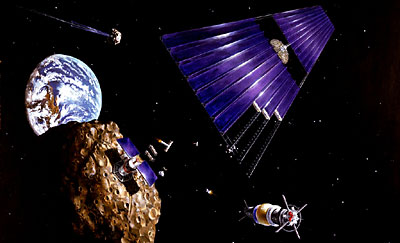Economic growth and space development over the long haulby Nader Elhefnawy
|
| The plain truth is that relying on terrestrial economic expansion to endow us with the resources for eventual space expansion will mean admitting the most exciting things are further off than we would like. |
No less important is the expansion of the economic base that would have to support such endeavors, a point which rarely gets much attention. There is an obvious reason why that approach is often ignored: the common claim that the limits to growth on Earth mandate a turn to the exploitation of space. (Such arguments are not exclusive to the writers of the 1970s. John S. Lewis posits that the failure to do so will mean “civilization collapses to subsistence agriculture by 2030” in his 1996 book Mining the Sky.)
However, this is far from being the only reason. The plain truth is that relying on terrestrial economic expansion to endow us with the resources for eventual space expansion will mean admitting the most exciting things are further off than we would like, outside the time frame of “meaningful” discussions of what public policy should be or what private business can do. Besides, it makes for a less compelling and attractive story than the idea of a technological revolution just over the horizon that opens up the heavens to all of us—especially if one is a market romantic when it comes to these matters (see “Market romanticism and the outlook for private space development”, The Space Review, September 2, 2008).
Nonetheless, that is what one would have to assume given the state of the art. Additionally, however, while space launch costs (and other, related costs) may drop in real terms in the coming decades, it is safe to say that any viable future spacefaring society will also see them drop markedly in relative terms. The United Nations predicts the rise of Gross World Product (GWP) to about $140 trillion by 2050, more than twice today’s level, and this is still rather conservative next to some previous periods of comparable length. A repeat of the growth of 1950–1990, for instance, would likely result in a GWP in the $250–350 trillion range. And of course, if one goes in for that sort of thinking, the growth we could realize if the predictions of futurists like Ray Kurzweil pan out would absolutely explode those numbers.
Of course, some caution is in order. Given the challenges the world now faces, including tight energy supplies, ecological degradation, and financial instability (and the huge uncertainties involved in not just space, but other technologies like molecular engineering and robotics), it is easy to picture even the modest numbers supplied by the UN proving overoptimistic.
Additionally, even if these levels of income actually are attained (and the possibility is certainly worth considering), one should not get carried away in fantasizing about their significance. Joseph Schumpeter once considered the prospect of a per capita U.S. GDP of $1300 ($16,700 in today’s dollars) in 1978. It seemed obvious to him that at such a level of income:
all the desiderata that have so far been espoused by any social reformers—practically without exception, including even the greater part of the cranks—either would be fulfilled automatically or could be fulfilled without significant interference with the capitalist process.
Put more plainly, he argued that “this would do away with anything that according to present standards could be called poverty, even in the lowest strata of the population.”
Schumpeter’s scenario was both overly pessimistic, and overly optimistic. As it turned out, the US economy grew far more rapidly than that. By 1978 America’s per capita GDP was about fifty percent higher than in his prediction, some $25,000. However, the utopian results he described did not come about. Indeed, it is worth noting that Botswana and Estonia today meet the level of economic development he described. No one considers either of those countries to be anything close to “poverty-free”.
| In the end, rather than banking on space as a way out of Earth’s short-run problems, solving those problems here on Earth, with the resources at hand, is likely to be crucial to meeting the long-run demands of space flight. |
This danger of overestimating the significance of a given level of income certainly carries over to discussions of how large a space program a country (or the international community as a whole) can afford. US GDP in 1970 was roughly forty percent what it is today, but the NASA budget is actually a little smaller. Clearly, growth alone (at least as conventionally measured) did not suffice to fund a more ambitious space program.
Nonetheless, even if one should not get carried away by seemingly staggering numbers, the fact of higher output still means an enlarged range of options. Just as China’s economic growth has made its new ambitions in space more than just a dream (even if many of its plans have yet to prove to be realistic), a space project of any given size would seem far more affordable in a world where global wealth had risen by a factor of two, three, or five.
This will especially be the case if all that growth has developed along with fiscal sanity, poverty reduction, and better resource management—the failure to achieve which has been the Achilles’ heel of growth in recent decades. (To give just one example, the net financial liabilities of the Group of Seven industrial countries quadrupled as a share of their GDP between 1974 and 2006, tightening their budgets even as their economies got much bigger, according to the Canadian Ministry of Finance.) In the end, rather than banking on space as a way out of Earth’s short-run problems, solving those problems here on Earth, with the resources at hand, is likely to be crucial to meeting the long-run demands of space flight.
